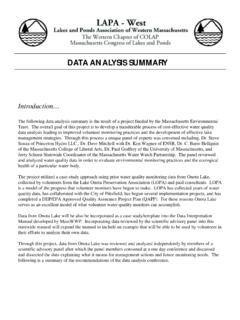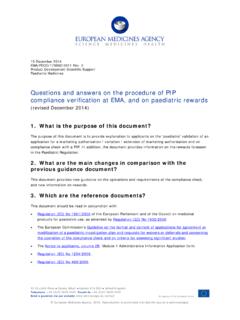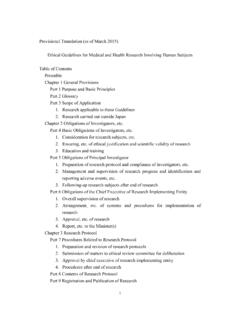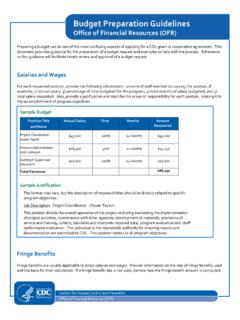Transcription of QUALITY OF LIFE ASSESSMENT MANUAL
1 QUALITY of life ASSESSMENT Project QUALITY OF life ASSESSMENT MANUAL Marion A. Becker, Bret R. Shaw Lisa M. Reib QUALITY of life ASSESSMENT MANUAL Table of Contents Introduction Preface .. 1 Historical Context .. 1 The Wisconsin QUALITY of life Index .. 2 Validation of the Instruments .. 2 Cultural Translations .. 3 Introduction to Coding and Scoring .. 4 W-QLI Conceptual Model .. 5 Example of Individual QoL Data from Client and Provider Perspectives .. 6 Example of Aggregate QoL Data Display .. 7 Taxonomy of Goals .. 8 Wisconsin QUALITY of life Index (W-QLI) Client Questionnaire Conceptual Framework .. 9 Questionnaire .. 12 Wisconsin QUALITY of life Index (W-QLI) Provider Questionnaire Conceptual Framework .. 21 Questionnaire .. 23 Wisconsin QUALITY of life Index (W-QLI) Caregiver Questionnaire Conceptual Framework.
2 29 Questionnaire .. 31 QUALITY of life Index for Adults (A-QLI) Questionnaire Conceptual Framework .. 39 A-QLI Conceptual Model .. 41 Questionnaire .. 42 QUALITY of life Index for Adults (A-QLI) Provider Questionnaire Conceptual Framework .. 52 Questionnaire .. 53 The Family QUALITY of life Index (F-QLI) Conceptual Framework .. 60 F-QLI Conceptual Model .. 62 Questionnaire .. 63 The Family QUALITY of life Index (F-QLI) Provider Questionnaire Conceptual Framework .. 75 Questionnaire .. 76 W-QLI User Agreement .. 82 A-QLI and F-QLI User Agreement .. 83 Requesting an Index .. 84 Preface QUALITY of life (QoL) is fast becoming a standard measure of outcomes in clinical trials, cost effectiveness analysis and clinical practice. A confluence of forces including rising health care costs, concern over reported poor QoL of psychiatric patients living in the community and an awakening recognition that customary measures of treatment measures are inadequate has focused attention on the need to measure and improve QoL for persons with mental illness.
3 Unfortunately, methods for combining clinical data with client perceptions and goals for improvement with treatment are not standardized. In addition, there are likely to be differences about the relative importance of different domains. Clinicians, families and the clients themselves may have a very different view of the client s QoL and the important goals of therapy. QUALITY of life is a subjective construct which varies with the population studied. It is generally conceptualized as a multi-dimensional construct made up of a number of independent domains including physical health, psychological well-being, social relationships, functional roles and subjective sense of life satisfaction. Each QoL domain can be assessed from the point of view of the clinician, client or caregiver, and the relative weighting of the importance of each domain can also vary from one observer to another.
4 This QUALITY of life ASSESSMENT MANUAL is an introduction to seven QoL ASSESSMENT measures developed by the QUALITY of life ASSESSMENT Project at the University of Wisconsin - Madison. The MANUAL provides an overview of QoL ASSESSMENT for three distinct groups including families, older adults and adults with serious mental illness. This document also describes the conceptual framework for the instruments and illustrates some of the ways that outcome data may be presented and used. The instruments presented here embody a multi-disciplinary approach to outcomes and present the work of a diverse team of researchers from the University of Wisconsin - Madison including: principal Investigator Marion A. Becker, , RN Social Work, Nursing & Gerontology Co- principal Investigator Ronald Diamond, MD Psychiatry Co- investigators Francois Sainfort, Industrual Engineering Jeffery Douglas, Biostatistics Research Assistants Eric Grodsky, Sociology Bret R.
5 Shaw, Journalism and Mass Communication Lisa M. Reib Journalism and Mass Communication Historical Context The QUALITY of life ASSESSMENT Tools provided in this MANUAL were developed for clinical and research use. The first Wisconsin QUALITY of life Index (W-QLI) was developed for use in mental health in response to a need to provide appropriate information in the Wisconsin Medicaid Program for reauthorization of clozaril. Clozaril was then a new and expensive antipsychotic medication. At the time of development, outcomes in psychiatric patients were being measured predominantly in terms of symptoms. In fact, the Medicaid programs in 30 of 50 states in America were using a symptom improvement criteria for reauthorization of the drug under Medicaid reimbursement. Most were using a 20 percent symptom improvement criteria based on outcome measured with the Brief Psychiatric Rating Scale.
6 (1). When clozaril was approved for use, the field lacked an inexpensive, easy-to-use, comprehensive QoL ASSESSMENT tool for use in busy mental health settings. Our primary objective was to develop an inexpensive, easy-to-use, self-report and self-administered instrument that would reflect consumer values and goals for improvement with treatment. An advisory board was convened to guide the scale development and ensure that consumer needs were incorporated. We realized that the clinical and practical usefulness of an ASSESSMENT instrument would be key to its successful adoption and use in the field. Thus, we developed an instrument that could be used to assess patient status, and that could also be used for monitoring and evaluating patient outcomes over time. Important features of all QoL instruments developed by the principal investigator are their dimensionality, inclusion of consumer goals, and provisions for multiple respondents.
7 Descriptions of the index domains and underlying conceptual frameworks are provided in subsequent sections of this MANUAL . The multi-dimensional conceptual model for the W-QLI is found on page 5. The Wisconsin QUALITY of life Index The Wisconsin QUALITY of life Index (W-QLI) for use in mental health has been made available to investigators in community settings, academia and the pharmaceutical industry. In exchange for early access to the W-QLI, anonymous data sets have been provided to the developers for psychometric evaluation. Early application studies were primarily conducted in community support programs (CSP s). However, the W-QLI has also been used in hospital settings, clinical trials, a private doctor s office, and mental health care units of health maintenance organizations. Studies currently in the field in the United States focus primarily on persons with chronic mental illness.
8 The majority of responders have carried a diagnosis of schizophrenia, although the W-QLI has also been used in a populations of persons with borderline personality disorder and with major affective disorder. The W-QLI has been used for program evaluation as well as for the purpose of comparing outcomes of different service models ( a Program for Assertive Community Treatment (PACT) and a Fountain House Model Program). Validation of the Instruments The W-QLI index was field tested for clients and providers by using local mental health providers known to the authors. Results of the initial validation work have been reported in detail elsewhere.(2) In order to ensure content and face validity of the W-QLI, we based the conceptual framework and the development of the instrument on a comprehensive model of QoL that includes multiple dimensions as well as multiple perspectives on the client s QoL.
9 Furthermore, both consumers and professionals considered to have expertise and extensive experience with persons suffering from severe and persistent mental illness were involved in the development, definition and choice of items and/or scales to be included to represent these multiple dimensions of life QUALITY . Finally, to the extent possible, existing valid scales were chosen to capture some aspects of the various domains and dimensions of QoL. _____ (1) See The brief psychiatric rating scale, (p. 799-812) by J. Overall, D. Gorham, 1962, Psychological Report, Vol 10. (2) See A new patient focused index for measuing QUALITY of life in persons with severe and persistent mental illness, (p. 239-251) by M. Becker, R. Diamond, F. Sainfort, 1993, QUALITY of life Research, Vol 2. The QUALITY of life Index for Older Adults and the Family QUALITY of life Index are newer instruments in their initial stages of evaluation.
10 They are designed to follow the conceptual framework of the W-QLI. Cultural Translations The W-QLI has been culturally adapted/translated and harmonized for use in 12 countries using accepted international guidelines. Available translations include Afrikaans, Australian, Austrian, Canadian, Canadian French, Dutch, English, Finnish, French, German, Hebrew, Italian, Japanese Portuguese and Spanish. Efforts are currently underway in Canada, Italy and Spain to collect general population norms for the W-QLI. Cultural Adaptation Methodology: Cultural adaptation of the W-QLI was funded by in part by Janssen Research Foundation. Janssen wished to use the W-QLI to assess QoL of individuals suffering from schizophrenia. They contracted with Mapi Values in Lyon, France, who directed the work of the cultural adaptation using the following methodology: Recruitment of a QoL specialist as project manager in each of the countries involved.








